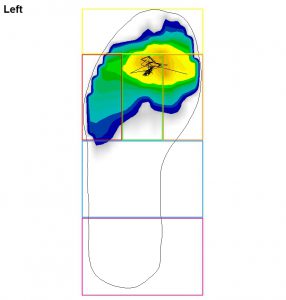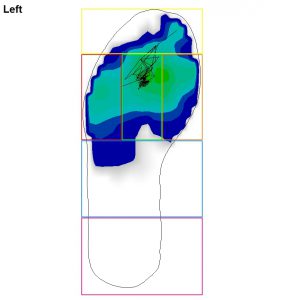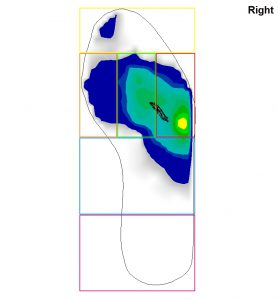Introduction / General
When it comes to power transmission between athlete and bicycle, cleats are of particular importance: They are the only connection between cycling shoe and pedal and can be individually adjusted: Besides the longitudinal and transversal axis almost all pedal systems can be adjusted in the Z-axis which in this case describes the rotation i.e. the angular position of the shoe in relation to the crank arm, in simple terms: whether the heel points towards the crank arm, remains in a neutral position or points away from the crank arm.
As adjustment basics for a neutral cleat position were already explained in numerous previous publications, I would like to skip this aspect in this article. At the end of this article some links can be found that explain basic adjustments, also Phil Burt’s book is a valuable literature tip. Basically every bike fitter who analyzes his/her athletes dynamically should be able to individually adjust the cleats. Nevertheless I would like to explain in this blog the effects of small adjustments of cleat position on the pressure distribution in the shoe. The following case studies are only a small part of the whole bike fitting process and are not to be conducted without consideration of further aspects of the sitting position.
Case study 1: Adjustment of cleats in longitudinal axis
In this example the athlete suffers from burning feet and numb toes on her left foot after riding her bike for approximately 30 minutes. By analyzing her original position some parameters such as saddle height and reach can be excluded as probable causes. Also the shoe model fits the dimensions of the feet. Pressure distribution of the left foot (image 1: baseline) shows a pressure peak in the front part of the ball of the foot (especially in the area of the metatarsal head (MTH) 2 with a value of 460 mbar. The center of pressure (CoP) underneath the foot (shown as black line) is mainly located in this area, too. It can be assumed that the nerve paths running there are overloaded in every pushing phase of the pedal stroke so that a reduced supply of the toes leads to the problems mentioned above.
By re-positioning the cleats 10 mm backwards, the whole pressure distribution was shifted to the middle of the ball of the foot. The center of pressure (CoP) is now located 8 mm further backwards and the maximum pressure peak is now 320 mbar. This means a reduction of 30%. The most important data is listed in the table below:
| PRE | POST | Comparison | |
| Max. pressure ball [mbar] | 460 | 320 | – 30% |
| Contact area ball [mm²] | 6375 | 6925 | + 9% |
| Contact area midfoot [mm²] | 425 | 2400 | + 464% |
| Force toes:ball [%] | 22:78 | 13:85 |
The adjusted cleat position leads to positive effects on the pressure distribution in the cycling shoe. The next step will be to adjust the saddle height to the new cleat position in order to avoid hyperextension of knee or ankle joint.
Case study 2: Adjustment of cleats in transversal axis
In the second case study the focus is on lateral shifting of cleats. The athlete complained about problems on the outer rim of the shoe, especially on longer or more intense rides. In this case we will focus on the analysis of the right foot:
In original position the highest pressure peak of 664 mbar is located at MTH 5, shown as yellow area in the pressure plot (image 3). Also the CoP is mainly located in the lateral area of the ball of the foot, therefore all in all 41% of the pedaling force are exerted from the outer rim of the ball.
By shifting the cleats 5 mm inwards the load beneath the foot is transferred towards the center (image 4). The “yellow” pressure area has now turned green which indicates a reduction of maximum pressure in this area. The detailed data analysis supports this observation:
| PRE | POST | Comparison | |
| Max pressure ball medial [mbar] | 174 | 325 | + 87% |
| Mean pressure ball medial [mbar] | 81 | 140 | + 74% |
| Max pressure ball lateral [mbar] | 664 | 539 | – 18% |
| Mean pressure ball lateral [mbar] | 307 | 280 | – 9% |
| Amplitude CoP [mm] | 25 | 46 | + 84% |
| Force medial:central:lateral [%] | 05:34:41 | 07:43:41 |
When comparing both measurements, a significant shift of pressure distribution in medial direction can be seen, e.g. an increase by 74% of the parameter “mean pressure” in zone “ball medial”. Due to this, maximum pressure at MTH 5 is reduced by 18%. Range of movement of applied pressure is wider which relieves the hurting areas, but is also a sign of reduced stability in the pressure phase. If this pattern of movement persists, stability should be increased again by using respective cycling insoles.
Conclusion
Also small adjustments of cleat position can have significant effects on pressure distribution in the shoe. Therefore the appropriate positioning of cleats should always be a part of the bike fitting process. Nevertheless the effects must not be overrated: Due to limited adjustment options offered by the cleats’ drill holes, the effects will be limited, too. The above mentioned case studies are “reproduceable” with any pedal system on the market, therefore I will not make specific recommendations with regard to the pedal system. Maybe in another blog?
Author:
Related literature:
Burt, Phil: Bike Fit. Bloomsbury Sport, 2014.
Carver, Todd: Bike Fit and Positioning. In: Cheung / Zabala: Cycling Science. Human Kinetics 2017. pages: 83/84





